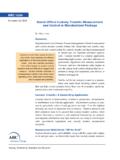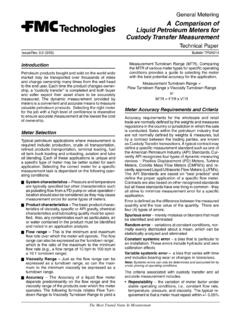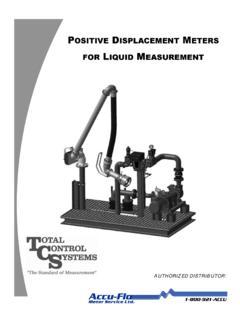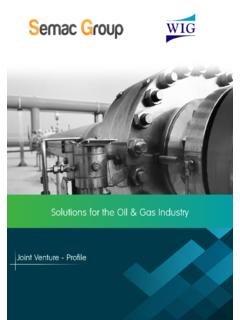Transcription of DESIGN, OPERATION AND MAINTENANCE OF …
1 design , OPERATION AND MAINTENANCE OF LACT UNITS Class Number 2090 Author Company Address INTRODUCTION This paper presents an overview of the design , OPERATION and MAINTENANCE of Lease Automatic Custody Transfer (LACT) units. These units are used for the automatic unattended measurement of quantity and quality of crude oil and sometimes other wellhead liquids when transferred from a producer to a pipeline for the account of a purchaser or consignee. This transfer usually takes place at a production lease site, hence, the use of Lease in the name. This can be on land or offshore delivering into pipelines, barges, or tanker loading and offloading operations . Similar units used to measure the transfer of other liquids or liquids between pipelines are often called ACT units since they usually are not associated with a crude oil production lease.
2 LACT units can range from small single meter, low pressure systems with portable proving connections to high-pressure systems with multiple meters and an on-site dedicated meter prover. Multiple smaller meters in parallel, instead of a single large meter, permit a larger range of permissible flow rates and reduces the prover size. Additionally, if one meter run fails, the LACT Unit can still operate at a somewhat lower capacity. LACT unit configurations vary considerably, but most units contain the basic equipment described here. More detail can be found in the American Petroleum Institute Manual of Petroleum Measurement Standards (API MPMS) Chapters 5, 6, 7, 8, 9, and 10. To ensure correct measurement of a petroleum liquid, the Lease Automatic Custody Transfer (LACT) equipment just be properly designed, operated and maintained.
3 design design considerations typically include product characteristics such as flow rate, viscosity, specific gravity, temperature, operating pressure and water content. Other design considerations include equipment selection for pumps, S&W monitoring, sampling, meters, control valves, meter proving facilities, etc. LACT units are usually designed to ANSI B piping code. Flow rate dictates sizes for pumps, meters and certain ancillary equipment. Low to moderate flow rates may be satisfied with a single meter run. High flow rates may require two or more meter runs in parallel. LACT units are usually installed on the suction side of shipping pumps to permit use of low-pressure equipment. High-pressure equipment can be very costly. Positive displacement shipping pumps must be fitted with pulsation dampeners to avoid shocking the meter with flow pulsations.
4 The basic elements of a LACT unit are: Metering The heart of the LACT is the meter which measures custody transfer volumes, usually in barrels. Most crude oil LACT units use positive displacement meters, but other types of meters are gaining popularity. The meter is usually installed downstream of a three-way valve and a property sized thermal relief valve. The meter measures the product stream and allows totalization either through a local totalizer or electronic pulses to a flow computer. The meter provides signals to a flow computer or PLC (Programmable Logic Controller) to allow: . Totalization of Oil Quantity Sample Pacing . Meter Proving . Meter Failure Alarm Types of Meters Historically, Positive Displacement (PD) and turbine meters have been the most often used meters in LACT units. Other meters are gaining acceptance, though, as experience and API standards become available.
5 Liquids with higher viscosity usually require PD meters, while liquids with low viscosity can be measured with turbine meters. The manufacturer s recommendations on the type of meter to be used should be followed. Positive Displacement (PD) Meters PD meters range in size from 2-inches to 16-inches and in flange ratings from 150# ANSI to 600# ANSI. Flow rates range from 60 to 13,000 barrels per hour. Larger sizes are available but are very costly. For high flow rates, it generally is better to use multiple meters in parallel. Turbine Meters Turbine meters range from 1-inch to 24-inches and ANSI ratings from 150# to 2500#. The flow rates range from nine barrels per hour to 57,100 barrels per hour. Heliflow Meters Heliflow meters, although new on the market, are gaining acceptance for applications in the mid-viscosity ranges.
6 Flow computers using double chronometry have allowed the Heliflow meters, which have a lower pulse frequency, to be used as custody transfer meters. Coriolis meters Coriolis meters feature no moving parts, high turndown ratios, and the ability to measure density as well as throughput. Coriolis meters measure directly in mass, but can measure volume by using the simultaneous internal density measurement. Meter accessories usually include the following: 1. A readout (register head) which is usually a large numeral counter that (optionally) may be reset to zero at the start of a run, and a small numeral non-resettable counter which is used for custody transfer measurement. The counter may also be fitted with a ticket printer that automatically stamps the ticket with the non-reset reading as the ticket is inserted (opening reading) and the closing reading when the ticket is pulled.
7 2. A high frequency pulse generator to provide pulses to a high-speed counter during meter proving. Alternatively, the meter stack may include a right angle drive to which a portable photoelectric transmitter may be attached to generate high frequency pulses. 3. A low resolution (low frequency) pulse generator used to operate samplers, meter failure alarms, local or remote meter totalizer, or remote combinator. A combinator is a device that provides the total volume from several meters. 4. Automatic temperature compensation. The common device on positive displacement meters is the ATC or ATG which is a mechanical device that converts measured barrels to equivalent barrels at 60 F. The ATC has a fixed conversion ratio. The ATG includes a gravity selector that permits the use of different conversion ratios based on different API gravities.
8 Many newer LACT units use electronic compensating totalizers to make the conversion to 60 F barrels. The electronic units suffer fewer failures than the mechanical units. Another device is the electronic temperature averager. This unit does not make the temperature conversion, but provides an average temperature over the run period. This average temperature is then used by a computerized accounting system to correct measured volumes to equivalent 60 F volumes. Many flow computers include the ability to directly convert volumes to 60 F volumes. Other meter instrumentation, located downstream of the meter may include: Temperature transmitter(s) with platinum RTD (Resistance Temperature Device) installed in a (Stainless Steel) thermowell. Pressure transmitter(s) with a pressure gauge mounted with a three-way gauge valve.
9 (Temperature and pressure transmitters send live readings to remote locations and/or to a flow computer for temperature compensation.) Thermowells installed close to temperature transmitters to facilitate calibration of the temperature transmitter or with a certified glass thermometer Charge Pump and Motor A charge pump is used to move liquid from the lease shipping tank through the LACT unit to a shipping pump. The charge pump must be sized to provide the desired flow rate(s) at design pressures for normal OPERATION . Centrifugal pumps are generally selected because they provide smooth flow without pulsations. Gear pumps are sometimes used because they deliver a constant flow rate regardless of pressure, but must be equipped with adequate pressure relief to protect the LACT against over pressure if the unit is inadvertently blocked in.
10 The LACT Unit should have a full flow relief valve upstream of the meter, and small sun-pressure relief valves between block valves. Special consideration is required when sizing the charge pump, to ensure that adequate NPSH (Net Positive Suction Head) is available to prevent cavitation, and that the discharge pressure is enough to overcome pressure drop through the LACT Unit to allow the required flow and pressure to the pipeline shipping pump inlet. Strainer/Air Eliminator/Deaerator Strainer A strainer should be included on the suction of the charge pump to protect the pump, meter and other equipment in the LACT Unit from grit and debris. The strainer contains a removable basket with a liner made from screen wire or perforated sheet metal. The strainer basket is usually made of carbon steel or stainless steel with 1/8 diameter holes on 3/16 centers.




